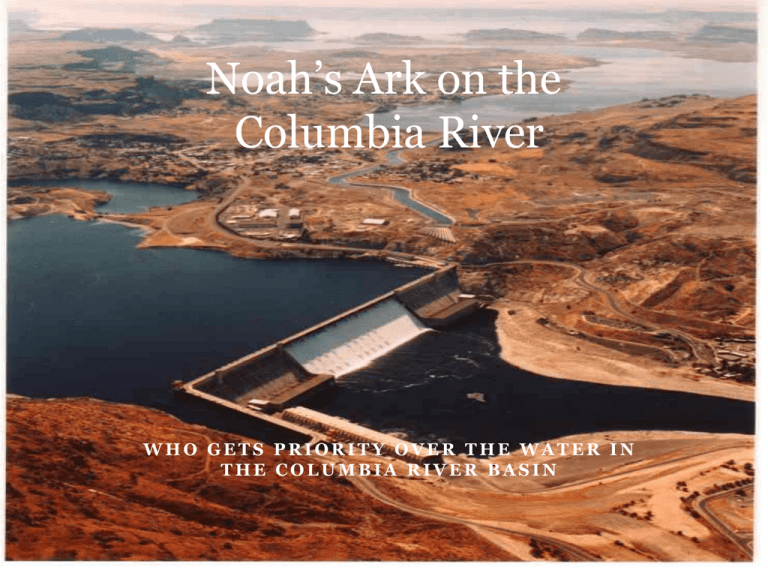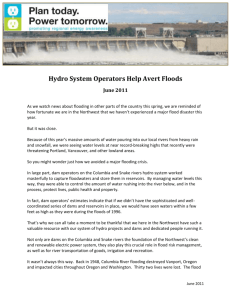Noah’s Ark on the Columbia River
advertisement

Noah’s Ark on the Columbia River WHO GETS PRIORITY OVER THE WATER IN THE COLUMBIA RIVER BASIN Columbia River Basin Four Competing Interests Flood Control Hydroelectric Power Endangered Species of Fish Irrigation Enabling Statutes of Dams Each dam has its own enabling statute that sets forth the uses for which it was built Each dam is was set up to control flooding on the Columbia, which can be very damaging Other uses for which it was authorized include power, irrigation, and recreation Two Flood Seasons On the upper Columbia, which runs through the arid plains of Eastern Washington – Winter snow run off West of the Cascade Mountains, the lower Columbia, rain from winter storms is the biggest source of water and leads to flooding Three Seasons Of Challenge Fall/Winter – in fall, smolts still running down, need to get flood control ready for winter rains west of the Cascade; in late fall, snow falls get upper basins ready while dams are emptying to supply winter heat; lower reservoirs collecting flood water from winter rains Spring – salmon start running; higher water levels as snow melts on upper river, lower has to keep putting water through to help salmon up Summer – salmon still running up the river; smolts starting to be washed; must have high water flows; works okay as well to generate AC; but also need to be refilling the dams for next year and for fall operations Endangered Species Act The “granddaddy of them all” First passed in 1973 Requires that any U.S. Government action be analyzed to see how it hurts endangered species Several types of fish in the basin are endangered Endangered Species Act Requires that “each Federal agency shall . . . Insure that any action authorized, funded, or carried out . . . Is not likely to jeopardize the continued existence of” an endangeared species or to harm it’s habitat. 16 U.S.C. 1536(a)(2) Further, it requires that a recovery plan is put in place to ensure the “conservation and survival” of the endangered species U.S.C. 1533(f) Endangered Species in the Columbia Snake River Sockeye Salmon 2. Spring, Summer and Fall Chinook Salmon 3. Snake River Steelhead Trout 4. Columbia River Steelhead Trout 13 fish species in total 2 1. 3&4 1 Priority of the Endangered Species Act Each of the dams that are administered by BPA has their own enabling statute The number one reason each damn is built is Flood Control Second priority is the Endangered Species Act – every operation other than flood control must be carried out to save the fish in the river Third is power production for BPA Irrigation Recreation 2008 Biological Opinion A 2008 Biological Opinion issued by the NOAA Fisheries guides the operation of the entire system of dams National Wildlife Federation Immediately filed suit, challenging the sufficiency of the 2008 BiOp Main claim – didn’t include or factor in global warming’s impact on the fish The case is National Wildlife Federation v. National Marine Fisheries Service, 3:01-cv00640-RE. 2010 Supplemental Opinion As a result, in 2010, NOAA issued a new BiOp. National Wildlife Federation took BPA, Army Corps of Engineers and Bureau of Reclamation to court to make sure that it is still applied But the 2010 Supplemental applies and dictates the “rule curves” by which the system has to operate. Irrigation Irrigation necessary to turn the desert lands east of the Cascades into agriculture Irrigation takes out 6% of all Columbia River Basin water supply; and takes out 9% of all water following over the Dalles, Oregon, the measuring spot for adequate flows Bonneville Power Administration (“BPA”) Federal Agency that is tasked with selling the power that is generated by the dams on the Columbia River Coordinates and markets power among federal dams and then among privately owned dams Also investing heavily in wind power and thermal generation plants to meet growing needs At times has to give away power because of the volume of water coming through the dams – interconnected on the grids Spun off its transmission division as FERC demanded Priority of Non-Power Uses Accomplished through the Pacific Northwest Coordination Agreement Members of the group include: Federal Agencies Investor-owned utilities Municipal Boards Public Utility Districts Private companies Synchronization As part of the Pacific Northwest Coordination Agreement, the planning follows a goal of Synchronization Synchronization means that for purposes of planning, the entire system is treated as if it had one owner, even though it is split among 17 companies. 2001 Drought Stresses the Agreement In 2001, Bonneville Power announced that it would be offering farmers up to $330 an acre for each acre of land they didn’t plow Did this so that they could keep using more water without diverting it to irrigation Drought had kept flow levels very low Preliminary Orders The Court in NWF v. NMFS continues to issue preliminary orders guiding the operations of the system since 2006 in the spring and summer In 2005, the court allowed the Fish and Wildlife service to kill Sea Lions in Oregon because they were eating too many salmon A 2010 consent order required that summer operations that followed the 2008 opinion and a supplemental opinion So which wins? Cold Winter Weather People? Fish and Endangered Species? O R 2007, BPA Puts Power before Species On April 10, 2007, the court overseeing NWF v. NMFS received an anonymous phone call saying that BPA was putting power before fish Court held a hearing, and determined that they had Big, Bad, BPA On April 3, 2007, a late cold snap was moving through the Pacific Northwest Reservoirs had been emptied to get them ready to control flood waters And BPA had agreed to sell power under contracts thinking it had a surplus BPA also had an equipment failure at a dam As a result, BPA ran more water through their hydroplants than they could under the BiOp then in effect Court issued an opinion reprimanding them, NWF v. NMFS, 2007 WL 1541730 (D. Or. May 23, 2007). Well, Which Is it? “I recognize that operating the FCRPS is ‘an incredibly complex task.’” “BPA’s choice . . . to . . . sacrifice the biological needs of listed species to satisfy its sales commitments to customers was wrong.” “The ESA is the law of the land . . . [i]t’s mandate is clear: federal agencies must ‘afford first priority to the declared national policy of saving endangered species.’” “We might as well get it right.” NWF v. NMFS, Judge James Redden





